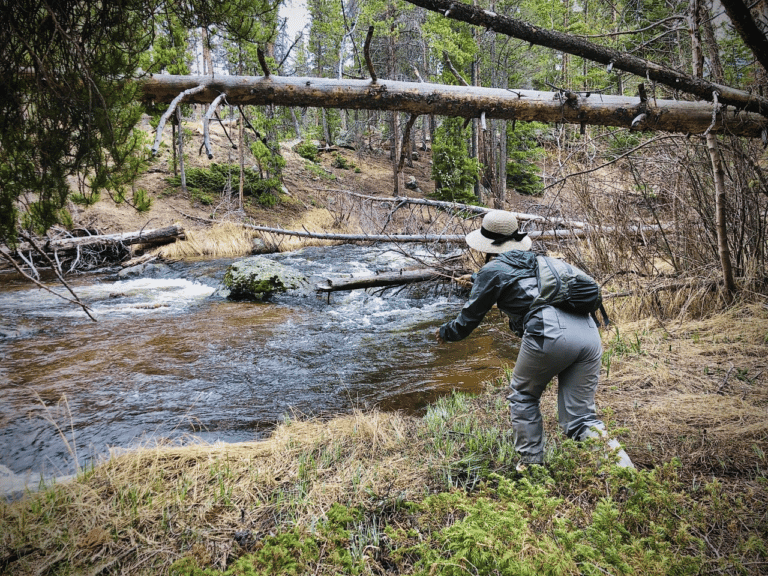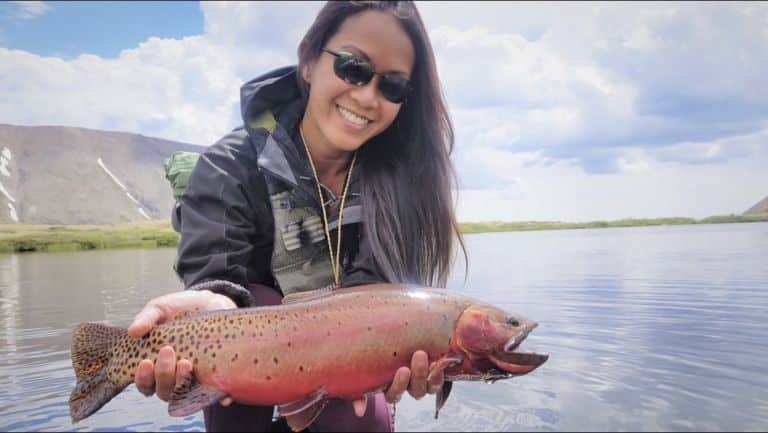When summer time comes around, one of my favorite things to do is exploring the mountain streams and lakes for wild trout. These can be some of the spookier trout you’ll come across since the water is crystal clear. Approaching and presentation are all-important in these waters that are fed by snowmelt. Doing a lot of little things right will add up to more and bigger fish caught. Sometimes all it takes is a heavy step, the appearance of a shadow, or the motion of a rod tip to send fish fleeing for cover. Approaching with Stealth to Spooky Trout is key.
Sometimes all it takes is a heavy step, the appearance of a shadow, or the motion of a rod tip to send fish fleeing for cover. Being stealthy is key.
Patience: Start with Observation
When reading the waters, it comes down with three basic conditions: What sort of coverage do the fish have? Where is the oxygen? What’s the available food supply? Be patient and observe the particular stretch of water before making your approach. As the water comes into view, survey and study it silently from a good distance. Keep in mind that the trout are very well camouflaged; just because you don’t see them right away doesn’t mean they’re not there. If you don’t see anything happening on the surface, start considering what depth changes and structure features might hold fish.
3 Basics - Coverage, Oxygen and Food Supply
Silent Steps
While shallow-water wading seems easy as far as movement, it can be challenging when it comes to preventing splashy noises and vibrations while walking in the water on slippery rocks. Dip your steps slowly down into the surface tension with minimal disturbance and slide your boots to creep into position. When possible, try to avoid wading at all, especially in stillwater situations.
Positioning and Current
Trout face upstream into the current in 99 percent of cases, so it’s safest to fish upstream because you’ll then approach them from their supposed “blind spot.” The truth is, trout sway back and forth in the current, sometimes darting sideways to feed. They also behave differently depending on their surroundings, to the point that a trout with a deep cutbank available may lie undercover for a while without moving, waiting for a meal to drift by.
In slow-moving or still waters that are shallower and have less structure, trout will feel or see you approaching more easily and from afar. In streams where the water alternates between fast riffles followed by long glides, your approach should be slow and stealthy. Unlike in pocket water where your approach is more hidden by the turbulent seams where the fish lie, the water’s surface is smooth and without distortion, and the fish can sense you from a long way off.
More streamside plantlife like willows, shrubs, and trees will often give you more cover to work with and let you get closer to where you plan to fish. In wide-open situations, you may need to stay farther back from the banks, keep very low, and/or make longer casts. Low-light days will always make things easier than bright and sunny ones. Also minimize false casting and utilize roll casts when possible to avoid spooking fish by having too much fly line in the air.

Get Low, Low, Low.....
Trout are very tuned in to things going on within their field of vision that’s in front of and above them. They are more concerned about threats from above than from below, as more of their predators tend to come from outside of the water. As such, being able to stay low when getting into a position where you can cast to feeding trout can often make a big difference. If you’re not lucky enough to be out on a foggy, low-light day when there’s plenty of water in the stream, or if you find yourself out on a lake with zero wind and bright sun, you may need to get low to fool some spooky fish. Crouch down on one knee so that your cast is lower and your profile is less visible. Use natural elements like boulders and stumps as cover, and don’t be afraid to cast from your kneeling position.
Minimize False Casts
Try ariel mend casts such as a reach mend or a wiggle cast to minimize the amount of mending your doing on the water.
Crouch down on one knee so that your cast is lower and your profile is less visible. Use natural elements like boulders and stumps as cover, and don't be afraid to cast from your kneeling position.
Watch the June UWOTF Virtual Meeting Presentation on Summer Trout Fishing Tips on Approaching Trout with Stealth, Nymph Fishing with a Strike Indicator and Alaska Fishing Techniques. Co-Hosts – Anh Thai, Jenn Hsia and Jackie Bowman.
Connect with Anh Thai
Anh started fly fishing on the Front Range streams near her home of Boulder, Colorado, where her passion for the outdoors has come hand in hand with exploring the high country for wild trout. While she fishes and ties flies year-round, backpacking to alpine lakes or mountain streams in search of cutthroat is her favorite summer pursuit. Anh also enjoys building and restoring bamboo and graphite rods. When she isn’t exploring new waters, Anh can be found mountaineering, climbing, or bird watching.





